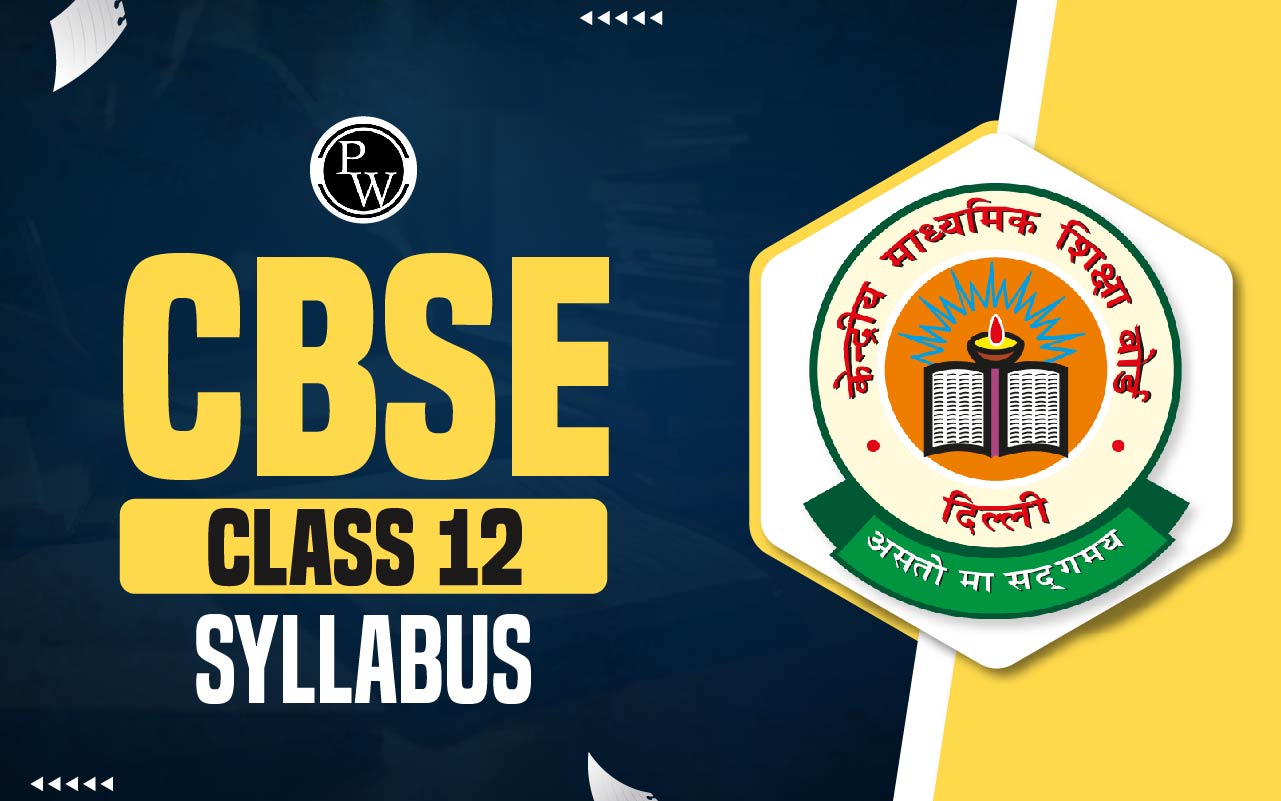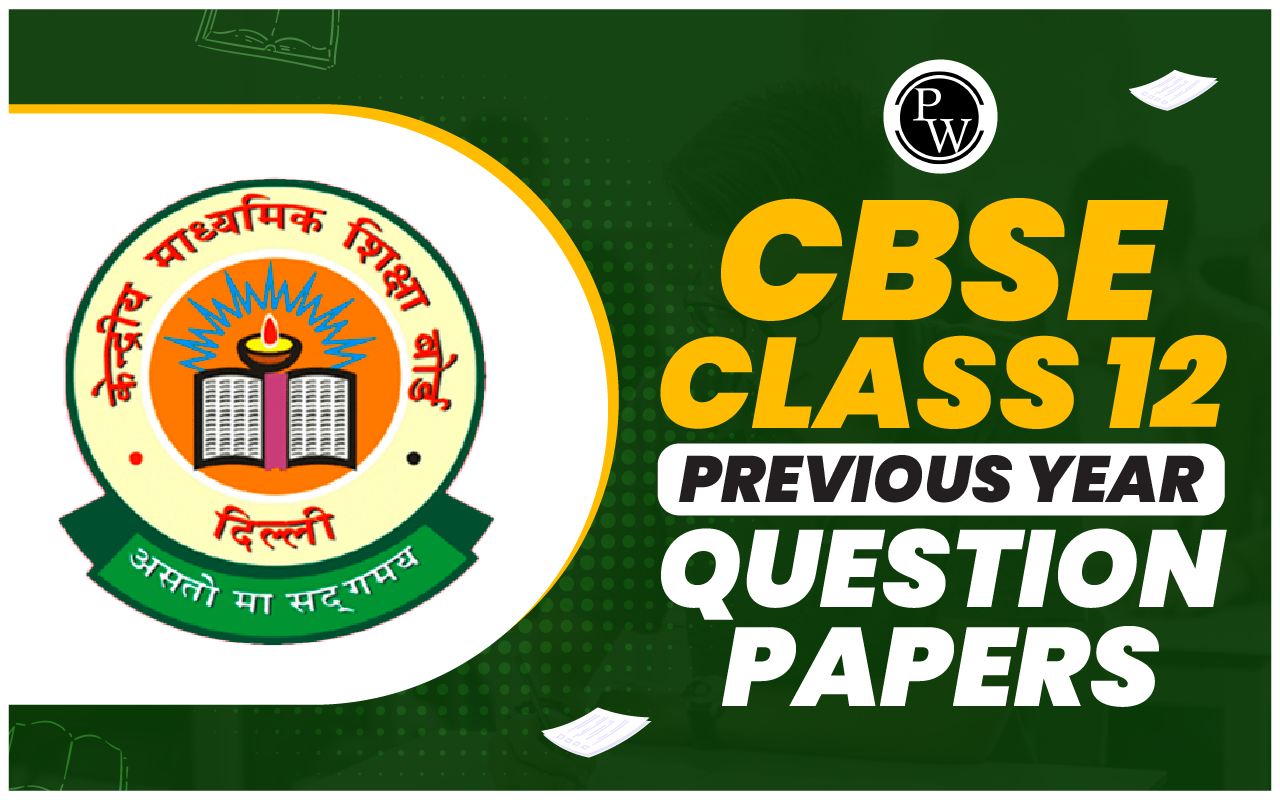
CBSE Class 12 Maths Notes Chapter 5: Chapter 5 of CBSE Class 12 Maths Continuity and Differentiability explain the foundational concepts of calculus. This chapter explains the idea of a function being continuous at a point, which means that the function doesn't have any abrupt breaks or jumps at that point.
The chapter also covers differentiability which deals with the ability to find a derivative of a function at any given point. Mastering these topics helps students build a strong understanding of calculus, essential for solving advanced mathematical problems.CBSE Class 12 Maths Notes Chapter 5 Continuity and Differentiability Overview
These notes for CBSE Class 12 Maths Chapter 5 Continuity and Differentiability have been prepared by subject experts of Physics Wallah. They provide a clear and simple explanation of the important concepts such as continuity of functions, differentiability and the relationship between the two. These notes will support you in mastering the chapter and performing well in your exams.CBSE Class 12 Maths Notes Chapter 5 PDF
The PDF for CBSE Class 12 Maths Notes Chapter 5 Continuity and Differentiability is available below. The notes are designed to help you grasp the chapter's topics easily and improve your problem-solving skills. Click the link below to access the PDF and strengthen your preparation for the exams.CBSE Class 12 Maths Notes Chapter 5 Continuity and Differentiability PDF
CBSE Class 12 Maths Notes Chapter 5 Continuity and Differentiability
Here we have provided CBSE Class 12 Maths Notes Chapter 5 Continuity and Differentiability-Introduction
Continuity and Differentiability are fundamental concepts in calculus, forming the backbone of many mathematical applications. Continuity refers to a function that is smooth and unbroken over its domain, without any gaps or jumps. Differentiability, on the other hand, deals with the rate of change of a function and focuses on finding the derivative, or slope, at any given point. Together, these concepts help in understanding the behavior of functions and solving complex problems involving rates of change, motion, and optimization.Continuity at a Point
A function f(x) is said to be continuous at a point x = a, if Left hand limit of f(x) at(x = a) = Right hand limit of f(x) at (x = a) = Value of f(x) at (x = a) i.e. if at x = a, LHL = RHL = f(a) where, LHL = lim x → a – f ( x ) and RHL = lim x → a + f ( x ) Note: To evaluate LHL of a function f(x) at (x = o), put x = a – h and to find RHL, put x = a + h.Continuity in an Interval
A function y = f(x) is said to be continuous in an interval (a, b), where a < b if and only if f(x) is continuous at every point in that interval.- Every identity function is continuous.
- Every constant function is continuous.
- Every polynomial function is continuous.
- Every rational function is continuous.
- All trigonometric functions are continuous in their domain.
Algebra of Continuous Functions
Suppose f and g are two real functions, continuous at real number c. Then,- f + g is continuous at x = c.
- f – g is continuous at x = c.
- f.g is continuous at x = c.
- cf is continuous, where c is any constant.
- ( f g ) is continuous at x = c, [provide g(c) ≠ 0]
Differentiability
A function f(x) is said to be differentiable at a point x = a, if Left hand derivative at (x = a) = Right hand derivative at (x = a) i.e. LHD at (x = a) = RHD (at x = a), where Right hand derivative, where Note: Every differentiable function is continuous but every continuous function is not differentiable.Differentiation: The process of finding a derivative of a function is called differentiation.

Theorems On Derivatives
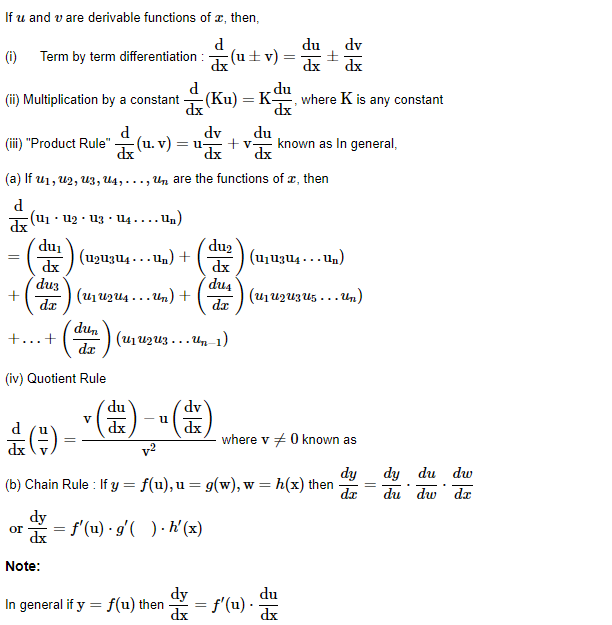
Methods of Differentiation
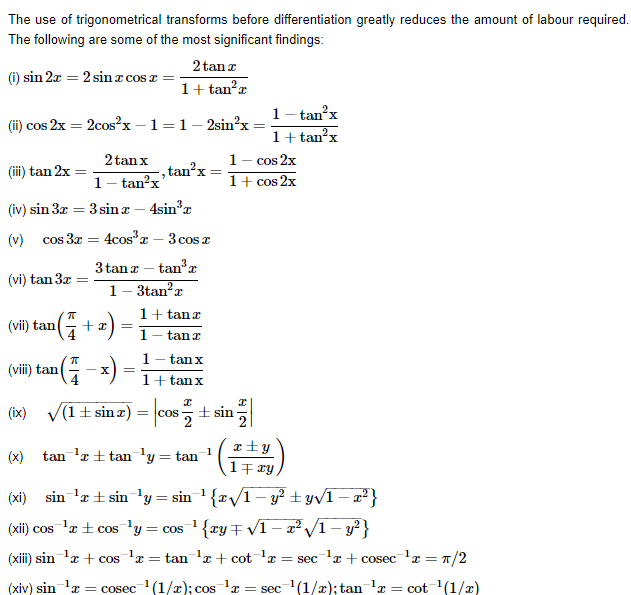
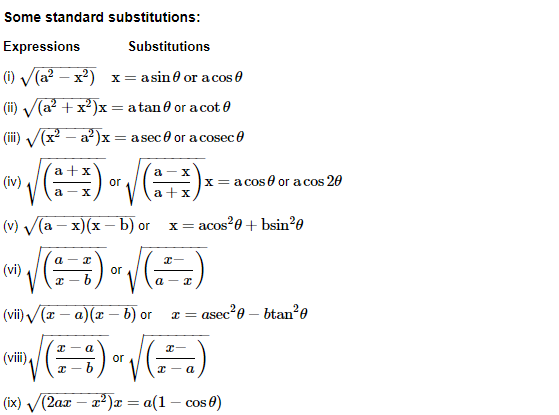
Derivative of Order Two & Three
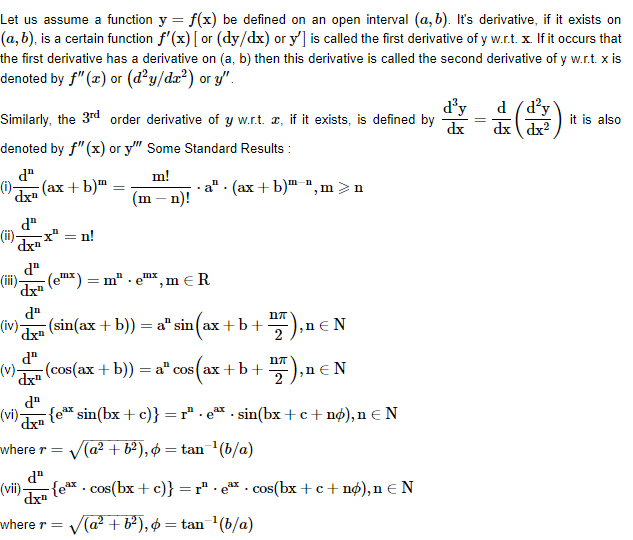 The
derivative of order two
and
derivative of order three
refer to taking the derivative of a function multiple times. These are also known as
second-order
and
third-order derivatives
.
The
derivative of order two
and
derivative of order three
refer to taking the derivative of a function multiple times. These are also known as
second-order
and
third-order derivatives
.
Second-Order Derivative :
- The second-order derivative is the derivative of the first derivative. If the first derivative represents the rate of change of a function, the second-order derivative gives the rate of change of that rate. It’s often used to analyze the concavity of a function.
Third-Order Derivative :
- The third-order derivative is the derivative of the second derivative. It gives the rate of change of the second derivative, which can help in more advanced analysis, such as in physics to understand acceleration changes.
A List of Continuous Functions
|
Function f ( x ) f(x) |
Interval in which f(x) is continuous |
|
|
1 |
Constant (c) |
( − ∞ , ∞ ) (−∞,∞) |
|
2 |
x n , n is an integer xn,n is an integer |
( − ∞ , ∞ ) (−∞,∞) |
|
3 |
x − n , n is a positive integer x−n,n is a positive integer |
( − ∞ , ∞ ) − { 0 } (−∞,∞)−{0} |
|
4 |
| x − a | |x−a| |
( − ∞ , ∞ ) (−∞,∞) |
|
5 |
P ( x ) = a 0 x n + a 1 x n − 1 + … . . + a n P(x)=a0xn+a1xn−1+…..+an |
( − ∞ , ∞ ) (−∞,∞) |
|
6 |
sin x sinx |
( − ∞ , ∞ ) (−∞,∞) |
|
7 |
cos x cosx |
( − ∞ , ∞ ) (−∞,∞) |
|
8 |
tan x tanx |
( − ∞ , ∞ ) − { ( 2 n + 1 ) π 2 : n ∈ I } (−∞,∞)−{(2n+1)π2:n∈I} |
|
9 |
cot x cotx |
( − ∞ , ∞ ) − { n π : n ∈ I (−∞,∞)−{nπ:n∈I |
|
10 |
sec x secx |
( − ∞ , ∞ ) − { ( 2 n + 1 ) (−∞,∞)−{(2n+1) |
|
11 |
cosec x cosecx |
π / 2 : n ∈ I π/2:n∈I |
|
12 |
e x ex |
( − ∞ , ∞ ) − { n π : n ∈ I } (−∞,∞)−{nπ:n∈I} |
|
13 |
log c x logcx |
( − ∞ , ∞ ) (−∞,∞) & ( 0 , ∞ ) (0,∞) |
Class 12 Chapter 5 Continuity and Differentiability Important Questions with Solutions
Question 1:
Explain the continuity of the function f(x) = sin x . cos xSolution:
We know that sin x and cos x are continuous functions. It is known that the product of two continuous functions is also a continuous function. Hence, the function f(x) = sin x . cos x is a continuous function.Question 2:
Determine the points of discontinuity of the composite function y = f[f(x)], given that, f(x) = 1/x-1.Solution:
Given that, f(x) = 1/x-1 We know that the function f(x) = 1/x-1 is discontinuous at x = 1 Now, for x ≠1, f[f(x)]= f(1/x-1) = 1/[(1/x-1)-1] = x-1/ 2-x, which is discontinuous at the point x = 2. Therefore, the points of discontinuity are x = 1 and x=2.Question 3:
If f (x) = |cos x|, find f’(3π/4)Solution:
Given that, f(x) = |cos x| When π/2 <x< π, cos x < 0, Thus, |cos x| = -cos x It means that, f(x) = -cos x Hence, f’(x) = sin x Therefore, f’(3π/4) = sin (3π/4) = 1/√2 f’(3π/4) = 1/√2Question 4:
Verify the mean value theorem for the following function f (x) = (x – 3) (x – 6) (x – 9) in [3, 5]Solution:
f(x)=(x−3)(x−6)(x−9) =(x−3)(x 2 −15x+54) =x 3 −18x 2 +99x−162 fc∈(3,5) f′(c)=f(5)−f(3)/5−3 f(5)=(5−3)(5−6)(5−9) =2(−1)(−4)=−8 f(3)=(3−3)(3−6)(3−9)=0 f′(c)=8−0/2=4 ∴f′(c)=3c 2 −36c+99 3c 2 −36c+99=4 3c 2 −36c+95=0 ax 2 +bx+c=0 a=3 b=−36 c=95 c=36±√(36) 2 −4(3)(95)/2(3) =36±√1296−1140/6 =36±12.496 c=8.8&c=4.8 c∈(3,5) f(x)=(x−3)(x−6)(x−9) on [3,5]Question 5:
Explain the continuity of the function f = |x| at x = 0.Solution:
From the given function, we define that, f(x) = {-x, if x<0 and x, if x≥0 It is clearly mentioned that the function is defined at 0 and f(0) = 0. Then the left-hand limit of f at 0 is Lim x→0- f(x)= lim x→0- (-x) = 0 Similarly for the right hand side, Lim x→0+ f(x)= lim x→0+ (x) = 0 Therefore, for the both left hand and the right hand limit, the value of the function coincide at the point x = 0. Therefore, the function f is continuous at the point x =0.Question 6:
If y= tan x + sec x , then show that d 2. y / dx 2 = cos x / (1-sin x) 2Solution:
Given that, y= tan x + sec x Now, the differentiate wih respect to x, we get dy/dx = sec 2 x + sec x tan x = (1/ cos 2 x) + (sin x/ cos 2 x) = (1+sinx)/ (1+sinx)(1-sin x) Thus, we get. dy/dx = 1/(1-sin x) Now, again differentiate with respect to x, we will get d 2 y / dx 2 = -(-cosx )/(1- sin x) 2 d 2 y / dx 2 = cos x / (1-sinx) 2 .Benefits of CBSE Class 12 Maths Notes Chapter 5 Continuity and Differentiability
Focused and Concise Content : The notes provide a summary of important concepts and formulas, helping students focus on the most relevant material for exams without unnecessary details.
Quick Revision : These notes are ideal for last-minute revision allowing students to quickly go over key points and refresh their understanding of the chapter before the exam.
Time-Saving : With organized content students can save time by studying only the important topics, ensuring they use their revision time efficiently.
Step-by-Step Solutions for Problems : The notes include solved examples that guide students through typical exam-style problems, helping them understand the correct approach and boosting their confidence for solving similar questions.
Enhances Problem-Solving Speed : Regular practice with these notes helps students become more familiar with the types of problems they will face in the exam, allowing them to solve questions more quickly and effectively.
CBSE Class 12 Maths Notes Chapter 5 FAQs
What is Continuity?
What is Differentiability?
Are all continuous functions differentiable?
What is the difference between continuity and differentiability?







